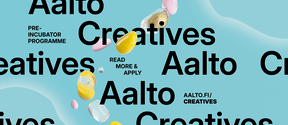Aalto University ranked globally among top 100 within its key research areas
The main priorities were research profile development, study path streamlining, decision-making on establishing one main campus in Otaniemi and the implementation of the financial balancing plan.
Aalto University’s updated degree programmes are turning out highly employable and sought-after international experts and innovators for industry, business and society. A record-breaking number of bachelors, masters and doctors graduated from the University in 2016. The University clearly exceeded all its degree targets set by the Ministry of Culture and Education, in Bachelor’s and Master’s Degrees, as well as doctorates.
The renewing and development of the University’s research profile continued apace through the appointment of professors to seven key research areas of the University. The Academy of Finland granted Aalto University a total of EUR 26 million to further strengthen the University’s research profile, which is a demonstration of the University's high quality of research. During 2016, the amount of refereed articles published in scientific journals showed an increase of 12%. Aalto University's publications received on average over 54% more citations compared to the citation average in the same fields worldwide.
Within its key research areas Aalto now ranks among the best 100 research institutes in the world. Times Higher Education ranked Aalto University 28th on its young universities ranking list, while Aalto’s Art and Design reached number 13 in the QS World Ranking. Aalto University’s Bachelor's Programme in Fashion ranked third in world ratings according to the Global Fashion School Rankings BOF, and Aalto University Executive Education (Aalto EE) reached 45th level in the Financial Times Executive Education Ranking, thus putting Aalto EE within the top 1% of executive educators in the world.
Aalto’s multidisciplinarity − the intensive cooperation between its different fields to generate new innovations − is the University’s operation principle and a primary strength. The Design Factoryconcept developed at Aalto is an example of the University’s boundary-breaking operating practices, for it has, over a short period of time, grown into an international network of 13 Design Factories.
A pioneer of entrepreneurship
Research, development and teaching carried out in open-development environments and together with partners and entrepreneurship education offered to all students as well as other collaborative business relationships are established operating principles of the University. The innovation ecosystem that has emerged around Aalto University is nationally renowned and competitive in the international arenas. It draws students, research institutes, companies and the international scientific community together. Annually, 70-100 companies are founded within Aalto community, and half of all start-ups originating from Finnish universities are founded at Aalto, according to a report by Tekes, the Finnish Funding Agency for Innovation.
Slush, a technology and start-up event founded by Aalto University’s students, has grown and become internationalised especially in Asia. Slush events have been organised in Tokyo, Shanghai, Singapore and Beijing and in dozens of smaller cities.
The University adapted to the changed economic situation
Savings in Government finances will result in cumulative cuts in the University's funding. The cuts in 2016–2018 will amount roughly to EUR 136 million, which includes the special national mission funding. Aalto University has, however, prepared a plan for balancing its finances to secure the achievement of the University's strategic goals and the long-term prerequisites for its core activities, regardless of the significant cuts to its funding.
In accordance with the plan for balancing its finances, the University has set ambitious goals for increasing particularly its competitive research funding. Aalto University will also use the returns from its endowment responsibly and plans to actively carry out fundraising. Additionally, the University aims to achieve significant savings in facility and procurement costs.
Despite of the measures taken, Aalto University was also forced to reduce its personnel costs. As a result of the statutory employer-employee negotiations that concluded in January 2016, it was decided that the number of employees would have to be reduced by 316, of which 165 would be covered by retirement arrangements and fixed-term contracts and 151 by redundancies. Measures will be implemented during the 2016-2018 period.
Financial statements showing deficit
The deficit in Aalto University's pro forma profit and loss statement was EUR 5 million (EUR 12 million in 2015). The operative profits were EUR 353 million (EUR 372 million), of which the university funding granted directly by the Ministry of Education and Culture accounted for EUR 237 (254) million. The total operative expenses were EUR 358 (385) million, of which personnel expenses accounted for 63% and facilities expenses for 18%.
The surplus recorded in investment activities was EUR 22 (30) million, and the surplus from fundraising was EUR 10 (1) million. Thus, Aalto University's net surplus for the financial year was EUR 16 (18) million. The balance sheet total increased from EUR 1.226 million to EUR 1.545 million.
The surplus of the Aalto University Group, consisting of Aalto University and its subsidiaries, for the financial year was EUR 25 (29) million. The Group's balance sheet totalled EUR 1.607 (1.485) million at the end of the financial year.
The Aalto University Board approved the Annual Board Report and Financial Statements for 2016 at its meeting of 28 March 2017.
Annual Board Report and Financial Statements 2016 (pdf)
More information:
Ilkka Niemelä, Provost, Aalto University, tel. +358 50 511 3013
Marianna Bom, CFO, Aalto University, tel. +358 50 575 3762
Read more news

Your voice gives away valuable personal information, so how do you keep that data safe?
With speech technologies becoming increasingly common, researchers want to make sure we don’t give away more information than we mean to.
A new way to measure contagion: the gut bacterium behind blood poisoning can spread like influenza
Neither the antibiotic-resistant nor the highly virulent strains are the most transmissible.
Cross-sectoral working group: Competitiveness, security and green transition must be promoted as a whole
A cross-sectoral working group for universities, businesses and cities is proposing that Finland speed up its international competitiveness, national security and green transition as one entity. The group suggests that, for example, defence procurement could support solutions aimed at a carbon-neutral society.






